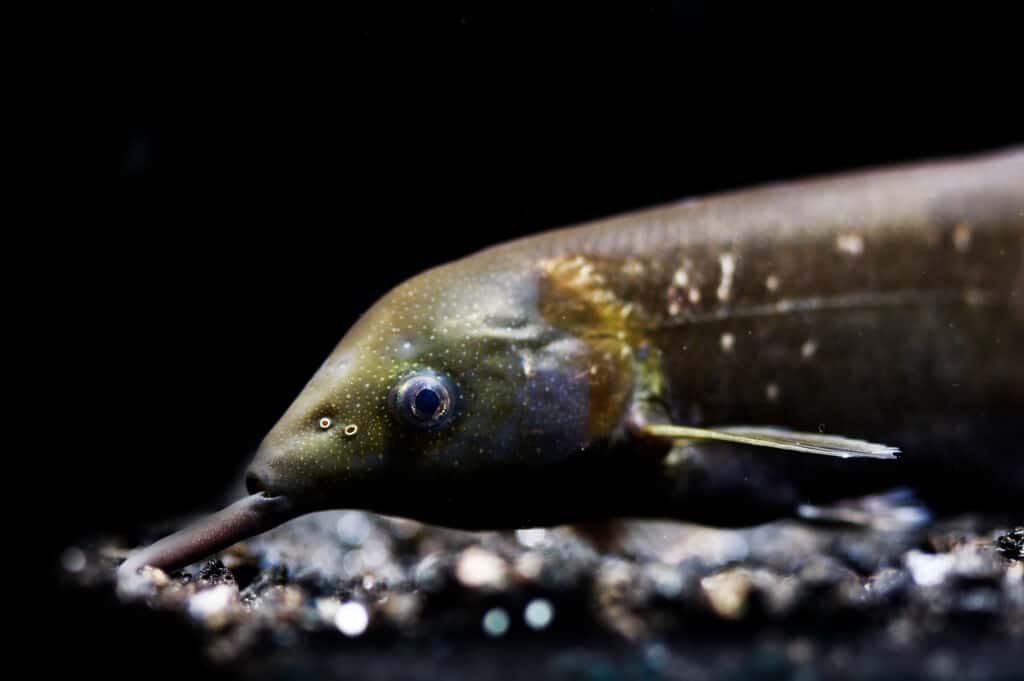Elephant Fish
Callorhinchus Milii
Elephant fish are known as the Australian ghost shark, but they are not actually a shark species!
Advertisement
Elephant Fish Scientific Classification
- Kingdom
- Animalia
- Phylum
- Chordata
- Class
- Chondrichthyes
- Order
- Holocephali
- Family
- Chimaeriformes
- Genus
- Callorhinchus
- Scientific Name
- Callorhinchus Milii
Read our Complete Guide to Classification of Animals.
Elephant Fish Conservation Status
Elephant Fish Facts
- Prey
- Crustaceans and mollusks
- Name Of Young
- pups
- Group Behavior
- Solitary
- Fun Fact
- Elephant fish are known as the Australian ghost shark, but they are not actually a shark species!
- Most Distinctive Feature
- Elongated snout
- Other Name(s)
- Australian Ghost shark
- Incubation Period
- 8 months
- Average Spawn Size
- 2 to 6 inches
- Habitat
- Sandy floor of the ocean
- Predators
- sharks
- Diet
- Carnivore
- Group
- shoal
Elephant Fish Physical Characteristics
- Color
- Brown
- Blue
- Black
- Skin Type
- Smooth
- Top Speed
- -2 mph
- Age of Sexual Maturity
- 3-5 years
- Venomous
- Yes
- Aggression
- Low
View all of the Elephant Fish images!
The elephant fish, also known as the Australian ghost shark, gets its name from its funny-looking elongated nose.
Elephant Fish Summary
The elephant fish, also known as the Australian ghost shark, is a unique-looking fish with an elongated, protruding snout. It is commonly feeding on mollusks or other invertebrates on the ocean floor of the South Pacific ocean. It is a popular seafood in Australia and New Zealand and is a very “tasty” option for fish and chips!
5 Incredible Elephant Fish Facts
- The elephant fish has no bones; instead, its skeletal structure is entirely cartilage.
- These fish have a special reflective tissue in their eyes, so their eyes can appear to transition between shades of yellow and green.
- It can be aggressive and fight back hard if threatened.
- These fish are very popular in cooking, particularly in Australia and New Zealand. They are common in fish n’ chips!
- Elephant fish females are usually larger than males.
Elephant Fish Scientific Name
Callorhinchus milii
Their genus name Callorhinchus is from the Greek words “kalo” meaning beautiful and “rhyngchos,” meaning snout. Zoologist Bory de Saint-Vincent first coined the name in 1823.
Elephant Fish Appearance

The elephant fish are demersal fish, meaning they live near the sea bed. They dive very deep into the ocean, thriving at depths of 600 to 5,000 ft below the surface.
©Pavaphon Supanantananont/Shutterstock.com
It is quite a unique looking bottom-feeding fish. Their most prominent feature is their extended snout. Elephant fish are about 2-4 feet in length. That’s the average height of a 3-6-year-old toddler! Once fully mature, they weigh about 10-15 lbs, but larger fish can even get as heavy as 20lbs if they have a rich diet. Their body is almost entirely scaleless and is generally a mixture of blue, black, or brown colors.
These are some of the most recognizable fish due to their outward extended snout. They have two dorsal fins, one near their head and one in the middle of their back. The dorsal fin in the middle of their back has a long spine that they use to defend themselves. Their spine contains small amounts of venom, but it likely is not enough to harm humans.
Their eyes are high on their heads and are a yellow-green color. Elephant fish also have large flat teeth, which is an adaptation that helps them consume their prey from the bottom of the ocean.
Elephant Fish Behavior
Elephant fish are solitary animals. They only pair up when breeding. They spend most of their time scouring the bottom of the ocean, feeding on the muddy and sandy seafloor. They filter feed, so their body automatically filters out the mud and sand while they consume the creatures living on the ocean floor.
Elephant Fish Habitat.
They are demersal fish, meaning they live near the sea bed. They dive very deep into the ocean, thriving at depths of 600 to 5,000 ft below the surface. They are in the South Pacific Ocean and Tasman Sea, in and around Australia and New Zealand.
Elephant Fish Diet
They are carnivorous fish, meaning that they eat only other animals. As bottom feeders, they will eat almost any invertebrate in their path, including small octopi, squid, worms, crustaceans, starfish, brittlestars, shrimp, sea cucumbers, and sea urchins. They can detect electrical currents in the water, which helps them seek out prey and find mates.
What Eats the Elephant Fish?
Elephant fish are quite large, but they still have many predators. Larger fish, such as hammerhead sharks, tiger sharks, and great white sharks, will often eat them.
What Does the Elephant Fish Eat?
The diet of this fish is based on small, soft invertebrate animals that live on the ocean floor, like octopi, mollusks, shrimp, and shellfish. They cannot eat bony fish because their teeth and digestive system don’t allow it.
Elephant Fish Predators and Threats
It is often preyed on by larger fish, such as sharks. Humans also commonly fish for elephant fish. Since they are boneless, they are used in cooking quite often. Currently, efforts have yet to be made to conserve these fish. So they are susceptible to overfishing.
Elephant Fish Reproduction
They are oviparous. In other words, they lay eggs. These fish usually mate in the spring and early summer (from October to January in the southern hemisphere). When mating, the males and females rise from the bottom of the sea to shallower waters. Elephant fish will locate mates using their ability to follow electrical fields.
The males have claspers that allow them to transfer their sperm to the female. The female then goes to even shallower waters to lay the eggs. Their keratinous eggs are then released onto the sandy ocean floor. At the beginning of the incubation period, the eggs are yellow in color, then they become brown, and they turn black right before they hatch. The egg incubation period is usually around 8 months, and the embryo feeds on the egg’s interior for nourishment.
Elephant fish males usually mature at around 3 years of age. The females mature slightly later at 4 to 5 years of age.
Elephant Fish Babies
Once hatched, the baby elephant fish are around 2-6 inches in length, depending on the nutrition they receive during their incubation. Their babies are known as pups. The egg case of these pups has a horny edge on one end, the end they crawl out of when they hatch. They usually hatch between October and November. Their leathery egg capsule then washes ashore after these pups have left their eggs.
The pups will stay in shallow waters for the first few weeks before they swim deeper into the ocean. They are completely independent when hatched and do not spend any time with their parents.
Elephant Fish Lifespan
Elephant fish live an average of 10 years, but in some cases, they have been known to live as long as 15 years. As they begin to age, they become more susceptible to ailments. Some of these include:
- Epitheliocytis – a condition of the skin and gills and fish due to a bacterial infection
- Parasites – parasites might begin to feed under the fish’s gills, causing damage to the scales.
- Columnaris – A disease that causes lesions on the fish’s back and belly. This is usually caused if the water is dirty or if the fish is malnourished.
- Fungal infections
Elephant Fish Population
The exact number of this fish in the world is unknown. However, due to the increase in the fishing of their species, their population is thought to be on the decline currently. Therefore, while their conservation status is presently least concern, this might change if no measures are taken to prevent their overfishing.
Similar Animals
View all 117 animals that start with EElephant Fish FAQs (Frequently Asked Questions)
Are elephant fish carnivores, herbavores, or omnivores?
Elephant fish are carnivorous fish that feed on deep-sea invertebrates such as small octopuses, jellyfish, and mollusks.
How do elephant fish communicate with one another?
Elephant fish can often detect the movements of other fish of their species via pores in their snout. They also have amplified vision owing to their large eyes, so they follow each others’ visual cues.
Are elephant fish venomous?
Yes, elephant fish have a long, slightly venomous spine on their back.
How fast can an elephant fish swim?
The elephant fish can swim at an estimated speed of 5mph, so they are slower in comparison to other fish.
How dangerous are elephant fish?
While these fish do have venom in their spine, they do not cause fatal harm to other fish or even humans.
How do elephant fish hunt?
Elephant fish hunt by sweeping across the bottom of the ocean and finding their prey by following electrical fields in the water.
Thank you for reading! Have some feedback for us? Contact the AZ Animals editorial team.
Sources
- Our Breathing Planet, Available here: https://www.ourbreathingplanet.com/australian-ghost-shark/
- Fandom Wiki, Available here: https://animals.fandom.com/wiki/Australian_Ghostshark
- Florida Museum, Available here: https://www.floridamuseum.ufl.edu/discover-fish/species-profiles/callorhinchus-milii/

















